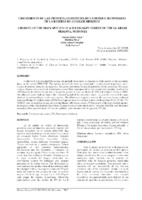Crecimiento de las principales especies de un bosque secundario de la reserva de Guaraní, Misiones
Growth of the main species of a secondary forest of the Guaraní reserve, Misiones
Date
2012-12-01Author
Vera, Norma Esther
Silva, Fidelina
López Cristóbal, Lidia Mirta
García, Daily
Metadata
Show full item recordAbstract
En el trabajo se evalúa el incremento periódico anual en diámetro para ocho especies del bosque secundario en el período 2003-2008. Las especies, seleccionadas por su importancia estructural y/o comercial fueron Leuhea divaricata, Matayba elaeagnoides, Nectandra lanceolata, Ocotea diospirifolia, Ocotea puberula, Nectandra saligna, Prunus subcoriacea y Ateleia glazioviana. Fueron agrupadas en dos muestras independientes diferenciadas por los diámetros o categoría de tamaños: mayor o igual a 20 cm de dap y menor a 20 cm de dap. Los resultados obtenidos señalan, que, en la etapa evaluada del bosque secundario, los crecimientos superan los obtenidos para bosques primarios de la misma reserva. Las diferencias de crecimiento entre las dos clases de tamaño evaluadas fueron significativas; los mayores valores de IPA para todas las especies fueron para la clase de tamaño mayor a 20 cm de dap. Las pruebas de ANOVA para cada grupo de tamaño, presentaron diferencias significativas entre las medias de IPA de las 8 especies consideradas. En el grupo mayor a 20 cm de dap, Leuhea divaricata se destacó por los menores IPA dap y Nectandra lanceolata, Ocotea puberula y Ocotea diospirifolia, por los mayores IPA dap. In this work it is evaluated the annual and periodic increments in diameter of eight species of the secondary forest in the period 2003-2008. The species selected for their structural and / or commercial importance were: Leuhea divaricata, Matayba elaeagnoides, Nectandra lanceolata, Ocotea diospirifolia, Ocotea puberula, Nectandra saligna, Prunus subcoriace) and Ateleia glazioviana. They were grouped in two independent samples, based on the differences in the diameters and size´s categories: greater or equal to 20 cm of DBH and minor to 20 cm of DBH. The obtained results indicate that in the evaluated period of the secondary forest, the growths exceeded the ones obtained for primary forests in the same reserve. The differences in growth between the two size classes evaluated were significant; the highest values of PAI for all species were for the class with a size larger than 20 cm of dbh. The ANOVA tests for each size group, showed significant differences between PAI averages of the eight studied species. In the group with a DBH greater than 20cm, Leuhea divaricata trees stood out for the minor PAI dbh, and Nectandra lanceolata, Ocotea puberula and Ocotea diospirifolia were the ones with the greatest PAI dbh.
URI
https://hdl.handle.net/20.500.12219/2725http://www.yvyrareta.com.ar/index.php/component/k2/item/95-creci-prin-esp
Collections
- Revista Yvyraretá [360]
The following license files are associated with this item:




